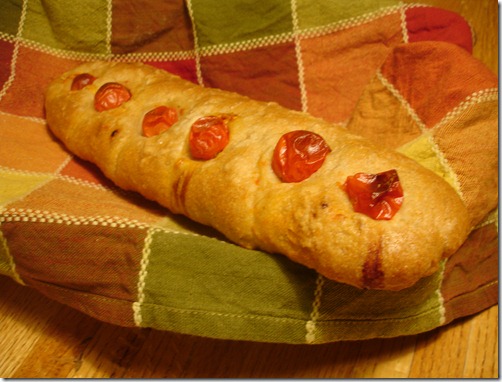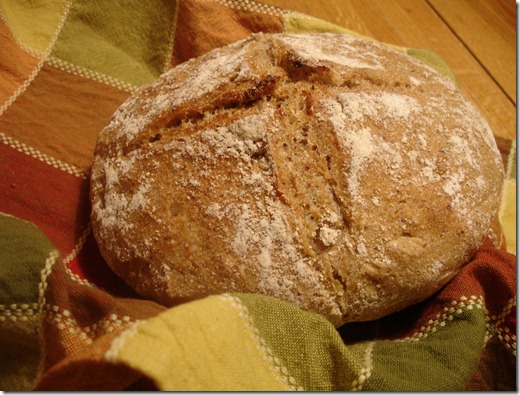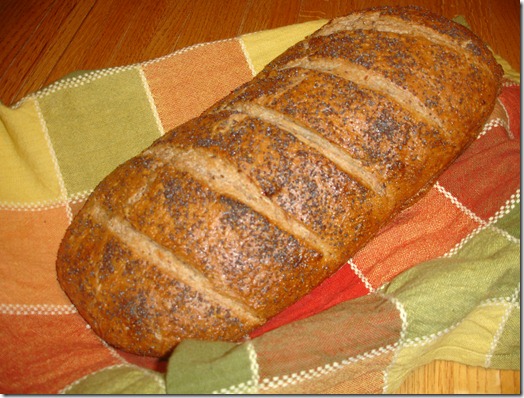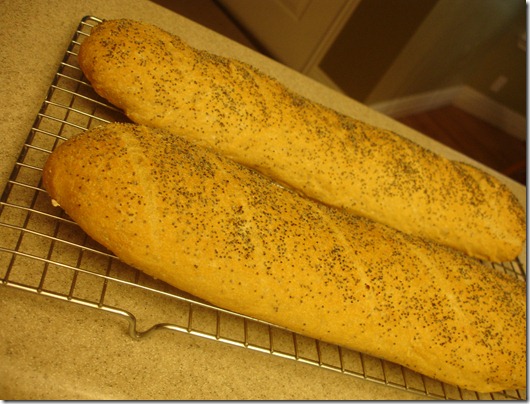I barely got to taste this—it disappeared fast. (And then I burned the second loaf when I put it back in the oven for a few more minutes and forgot it was there!) This bread has a different texture and crumb than the others I made for the bread class. It’s an enriched dough (contains eggs and oil and honey) and the bread is soft and barely sweet. I read in the book that the bread makes great French toast and the dough makes yummy
doughnuts. I can’t wait to experiment more with this recipe!
 Pumpkin Pie Brioche Dough
Pumpkin Pie Brioche Dough
from
Healthy Bread In Five Minutes a Day
By
Jeff Hertzberg, M.D., &
Zoë François
Makes enough dough for at least two 2-pound loaves.
3 cups white whole wheat flour
4 1/2 cups unbleached all-purpose flour
1 1/2 tablespoons granulated yeast, or 2 packets
1 tablespoon kosher salt (increase or decrease to taste)
2 tablespoons vital wheat gluten
1 teaspoon ground cinnamon
1/2 teaspoon ground ginger
1/2 teaspoon ground nutmeg
1/4 teaspoon ground allspice
1 1/4 cups lukewarm water
4 large eggs
1/2 cup honey
3/4 cup neutral-flavored oil, or unsalted butter, melted, or zero trans fat, zero hydrogenated oil margarine, melted
1 15 ounce can pumpkin puree
- Whisk together the flours, yeast, salt, vital wheat gluten, and spices in a 5-quart bowl, or a lidded (not airtight) food container.
- Combine the liquid ingredients with the pumpkin puree and mix them with the dry ingredients without kneading, using a spoon, a 14-cup food processor (with dough attachment), or a heavy-duty stand mixer (with paddle). You might need to use wet hands to get the last bit of flour to incorporate if you’re not using a machine.
- The dough will be loose, but it will firm up when chilled. Don’t try to use it without chilling for at least 2 hours. You may notice lumps in the dough, but they will disappear in your finished products.
- Cover (not airtight), and allow the dough to rest at room temperature until it rises and collapses (or flattens on top), approximately 2 hours.
- Refrigerate the dough in a lidded (not airtight) container and use over the next 5 days. Beyond that, the dough stores well in the freezer for up to 2 weeks in an airtight container. Freeze it in 2-pound portions. When using frozen dough, thaw it in the refrigerator for 24 hours before use, then allow the usual rest/rise times.
- On baking day, grease a brioche pan or an 8 1/2 x 4 1/2-inch nonstick loaf pan. Dust the surface of the refrigerated dough with flour and cut off a 2-pound (cantaloupe-size) piece of dough. Dust the piece with more flour and quickly shape it into a ball. Place the ball in the prepared pan and allow to rest, loosely covered with plastic wrap, for 1 hour 45 minutes.
- Thirty minutes before baking time, preheat the oven to 350 degrees F, with a rack placed in the center of the oven. If you’re not using a stone in the oven, a 5-minute preheat is adequate.
- Just before baking, use a pastry brush to paint the loaf’s top with egg wash, and then sprinkle with raw sugar.
- Bake near the center of the oven for approximately 45 to 50 minutes. Brioche will not form a hard, crackling crust. The loaf is done when it is medium brown and firm. Smaller or larger loaves will require adjustments in resting and baking time.
- Remove the brioche from the pan and allow it to cool on a rack before slicing or eating.
 In this week’s cooking class we made artisan breads and pizza from a no-knead dough. I first learned of this technique from the book, “Artisan Bread in Five Minutes a Day” by Jeff Hertzberg and Zoë Francois. I checked it out from the library and loved the simple and delicious breads in it, but didn’t bake them very often because I don’t like using white flour. Lucky for me, their second book came out last year, called “Healthy Bread in Five Minutes a Day. I love this book! All of the recipes used for the cooking class came from this book, but there are other cookbooks out there with similar bread-making techniques. Look for “Kneadlessly Simple” or “My Bread” if you’d like to experiment further. Here are some links to more information. I’d especially recommend the tutorial video if you missed my class—it helps to watch someone (in this case, the authors of the book) mix and shape the dough. All of the recipes that I made for the class are on this blog—just scroll down. Happy baking!
In this week’s cooking class we made artisan breads and pizza from a no-knead dough. I first learned of this technique from the book, “Artisan Bread in Five Minutes a Day” by Jeff Hertzberg and Zoë Francois. I checked it out from the library and loved the simple and delicious breads in it, but didn’t bake them very often because I don’t like using white flour. Lucky for me, their second book came out last year, called “Healthy Bread in Five Minutes a Day. I love this book! All of the recipes used for the cooking class came from this book, but there are other cookbooks out there with similar bread-making techniques. Look for “Kneadlessly Simple” or “My Bread” if you’d like to experiment further. Here are some links to more information. I’d especially recommend the tutorial video if you missed my class—it helps to watch someone (in this case, the authors of the book) mix and shape the dough. All of the recipes that I made for the class are on this blog—just scroll down. Happy baking! 




